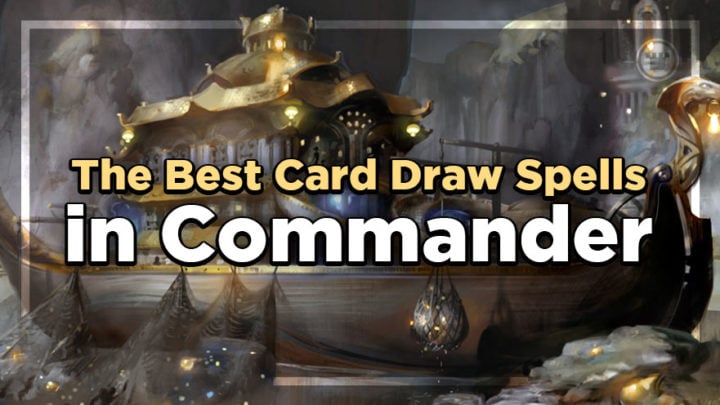Card draw makes the format go round. Without it, each player’s hand would be empty by turns 4 or 5, and every game would become a slog. It’s critical to make sure your deck has enough to keep up with the table, and to help you find the right answers at the right time. But with so many options, where are you supposed to start?
Today, I’ll be discussing card draw spells in each color, and breaking them down into two main categories: single use cards and engines. By “single use,” I mean spells that have a one-time effect, such as instants and sorceries. Engines let you draw multiple cards over a longer period of time; these tend to be permanents that give you more consistency over several turns. Both are important, and should probably be included in most decks.
While the cards I talk about below are some of the best in their colors, I’m highlighting them as good starting points. I urge you to do your own research, either through looking at your commander’s page on EDHREC, or searching on Scryfall for the right cards for your deck.
White
It’s been a running joke that white is lacking in card draw; so much so that many colorless card draw artifacts from recent sets have been dubbed “the best white card in the set.” While it is true that raw card draw is limited in white, that doesn’t mean it’s devoid of card advantage. Many white cards provide value in different ways, like God-Eternal Oketra or Teshar, Ancestor’s Apostle’s cast triggers, though we won’t be talking about them here today as they don’t result in more physical cards being drawn.
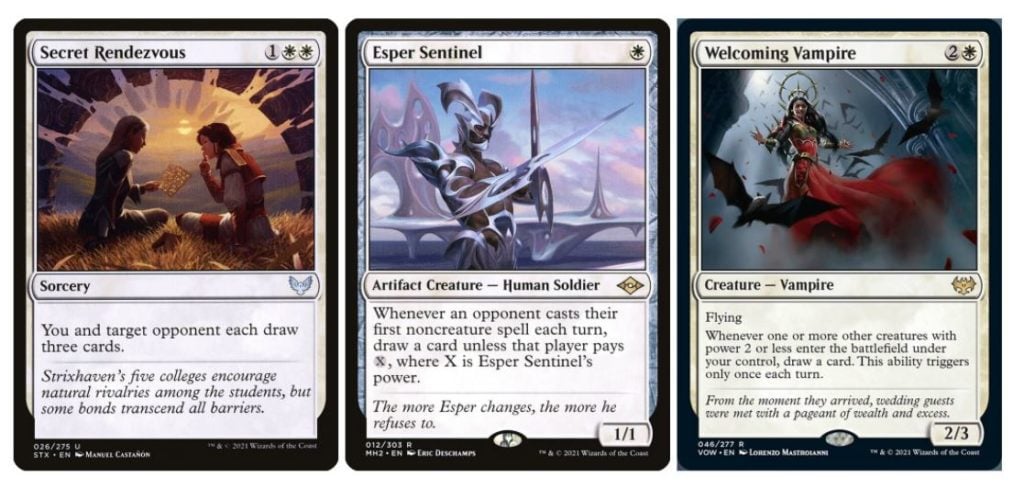
When Secret Rendezvous was previewed back in Strixhaven, opinions among players were divided. Some players hated it, as it might put an opponent ahead of you; others saw it as one of the best bargaining chips to come out in recent times. I’m in the latter camp. Not only is this solid card draw in white, it’s also a phenomenal way to garner the favor of another player. If you were asked to kill a threat or refrain from attacking a player for a turn or two, on the promise of a free Ancestral Recall, I’m certain you’d take it! To me, this card reads: “You and target opponent each draw three cards, then you become friends,” and that’s how it’s played out every time for me.
For more continuous effects in white, you’d be looking at creatures and effects that want battlefield presence. Esper Sentinel is one of the newest and best on the list: a pseudo-Rhystic Study effect that can also attack is a fantastic deal for a single white mana. The monarch mechanic is also great in white, as you’re likely to have a lot of creatures in the color to make sure you can keep the crown. Court of Grace is a hugely popular addition from Commander Legends, and deserves a slot in many white decks.
Continuing with the creature theme, Welcoming Vampire is the latest in a line of card advantage engines that care specifically about smaller creatures. It may be limited to a single extra card per turn, but it won’t be long before they have paid for themselves many times over. Bygone Bishop and Mentor of the Meek are two more great choices for the role, and are often played side by side for double the effect. With multiples of these different effects in play, white can really keep up with some of the other colors!
Blue
Not all good card draw is blue, but all blue card draw is good. Not only are you flush with amazing options for single use card draw spells, but the continuous effects and engines are almost without equals (except maybe in green).
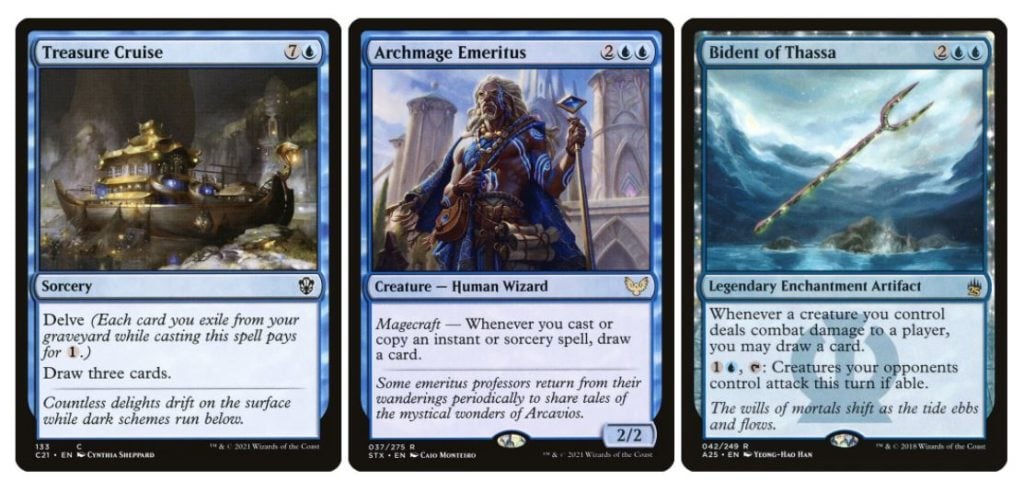
For single use spells, you’re truly spoiled for choice. Treasure Cruise is my go-to draw spell; you’re guaranteed to have cards enter the graveyard over the course of the game, so this will eventually become an Ancestral Recall. Fact or Fiction is another favorite, as it can get the table involved while always guaranteeing you at least three cards. If you’d rather have good effects attached to a body, Mulldrifter is the flying fish for you, especially for Blink or Sacrifice decks!
The main kind of repeatable card draw engine in blue is based on casting spells, whether yours or your opponents’. Archmage Emeritus is the best friend of any Spellslinger player, turning every cantrip into a one-mana draw two, and every other spell into a cantrip! Rhystic Study and Mystic Remora either tax or punish opponents for casting spells, both of which will be of great benefit to you. These are widely known and are fairly infamous at this point, which is a real testament to their power.
If you prefer your blue decks to involve the combat step, there are plenty of card draw engines to make sure the gas keeps flowing. Bident of Thassa, Coastal Piracy, and Reconnaissance Mission all reward you for every creature that connects with combat damage. These effects are particularly popular in decks with many small creatures, like Edric, Spymaster of Trest, Anowon, the Ruin Thief, and Tetsuko Umezawa, Fugitive. Evasive creatures can also make great use of these engines; Talrand’s Drakes and Ranar’s Spirits can use these to maximize your card draw.
Black
Black is known for being able to do anything… for a price (except destroying artifacts). It’s no surprise that it’s the color with some of the most solid and terrifying card draw spells in all of Magic. The drawback is that you usually have to pay life to use them — but life is a resource, and converting it into actual cards is often a great deal. Whether you’re looking for a few one-shot pieces to help keep your momentum going, a constant engine to keep you stocked throughout the game, or a blast of cards to overwhelm opponents on the spot, you’ll find what you need in the most ambitious color.
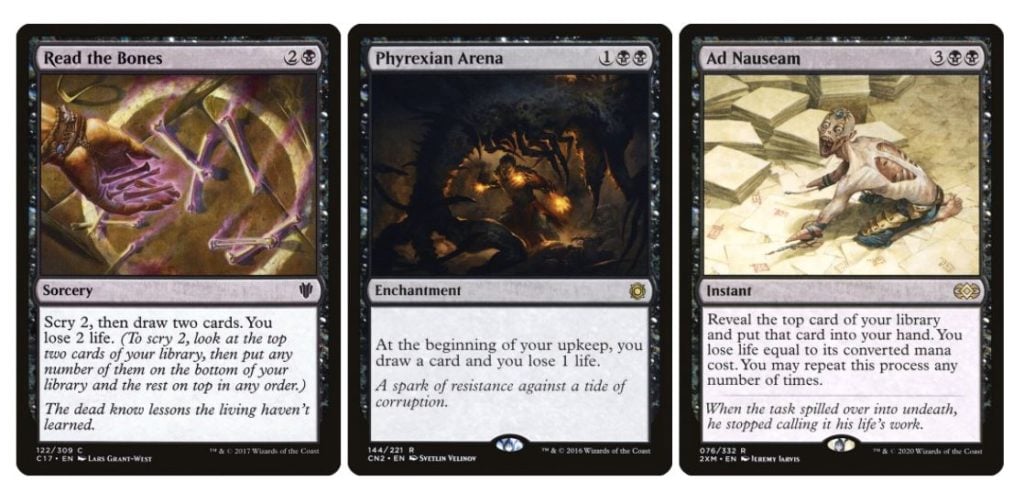
The most played black card draw spell (according to EDHREC) is Read the Bones. Compared to Divination, it’s a significant improvement: adding “scry 2” in exchange for two life is well worth it and can really smooth out your draws. Sign in Blood and Night’s Whisper are about as good, as they cost just two mana; it’s relatively normal to see these three spells in the one deck, as they can help improve consistency while keeping your hand stocked.
There are many permanents that provide a steady flow of card draw in black, too. The most famous one is probably Dark Confidant; it can be dangerous, especially in decks with higher average mana values, but an extra card per turn is often worth the risk. Keen Duelist is another version of Dark Confidant that works between you and another player; you can use it more politically to convince an opponent to work with you, or you can even set up the top of your deck to ensure they take the most damage possible every turn! Phyrexian Arena tends to be more popular than the others in Commander due to the fixed life loss; one life per turn is more than worth it to effectively double your regular card draw for the whole game!
If you’re looking for a sudden stream of cards to propel you ahead of the competition, black has exactly what you need. Ad Nauseam is one of the most powerful card draw spells ever printed. It might seem risky, but when you can control how many cards you draw and when you stop, you can draw more cards than you’ll likely ever need with very little risk. If you want a similar effect, Peer Into the Abyss is the next best thing. Drawing half your deck and losing half your life is always a great deal, and the drawback of it being a sorcery can be rough, but there are many decks that can still make it work. If you want something a little less explosive, however, Stinging Study can work wonders in the right deck. I play this in Syr Konrad, the Grim, and effectively drawing a new hand for five mana is a steal! I wouldn’t suggest this for decks with commanders that have a mana value below four, but otherwise, it really strikes a balance between the Ad Nauseam and Sign in Blood effects.
Red
Red is known for being the most emotive color, focusing on aggression, passion, and impulsivity with little regard for the long term. This is most evident in its card draw spells: almost all the card draw in red is “impulse draw,” named for Act on Impulse. Exiled cards must be used either that turn or before the end of the next turn, otherwise they’re gone forever; this is peak red design, and it’s something we’ve seen Wizards lean into in recent years. It has really helped red with its consistency issues, and makes it an extremely fun color to play.

Aside from the aforementioned Act on Impulse, we’ve been given Light Up the Stage and, more recently, Reckless Impulse. Functionally, they’re very similar, and should generally be included in any mono-red deck. If you’re casting a lot of spells, Galvanic Relay from Modern Horizons 2 is great for setting up a big turn, though you can’t touch the exiled cards until your next turn.
A lot of red card draw spells tend to be high velocity, low advantage; you’re drawing a lot of cards, but you won’t necessarily end up with more than you started with. Take Faithless Looting, for example: you draw two cards, but you have to discard two, and you used up the Faithless Looting. If you started with five cards in hand, you’ll be left with four once Looting has resolved. Cathartic Reunion and Thrill of Possibility are more examples of this kind of card draw effect. The best way to mitigate the card disadvantage is to incorporate cards that can provide value from the graveyard, like cards with flashback or jump-start. If you want some inspiration, you can read my article on how every Commander deck can use the graveyard!
As for continuous effects, red has a number of great options now. Chandra, Torch of Defiance is the Swiss Army Knife of red planeswalkers, and can fit well into almost any deck. Her +1 ability to impulse draw every turn is excellent, and when you combine it with her other abilities, she becomes a true powerhouse. Tectonic Giant and Valakut Awakening are two other options that can easily fit into any red deck that needs more card draw. Attacking and making land drops are two of the most fundamental parts of Magic, and being rewarded for simply playing the game is extremely potent.
Green
Green is arguably on par with blue as far as card draw is concerned, although it draws cards in different ways. While blue mainly uses single use card draw spells to keep the gas flowing, green relies heavily on creatures to provide the same benefit.

Harmonize is one of the most popular single use card draw spells in green, and for good reason. Three cards for four mana is a fairly good deal, no matter the power level. Return of the Wildpseaker and Rishkar’s Expertise are very popular, too; they require you to have a large creature in play, but if you do, the ceiling is absurdly high. I run both in my Mowu, Loyal Companion deck, and it’s reasonable for me to draw upwards of ten cards!
Toski, Bearer of Secrets really shines in go-wide strategies like Tokens or Elves, but works perfectly well in most creature decks. Sylvan Library is a classic repeatable card draw engine, and can net you an extra two cards per turn (provided you have the life to pay for it). Oakhame Adversary is another option for repeatable draw, albeit a lower impact one. It only draws cards when it deals damage, but opponents will rarely block it thanks to its deathtouch.
As I explained above, green really relies on creatures to draw cards. Beast Whisperer and Soul of the Harvest are two perfect examples, which each effectively add Elvish Visionary’s text box as a cast trigger to every creature in your deck. This can easily get out of hand with little effort, and are amazing additions to most green decks. Guardian Project gives you a similar effect, though it only triggers when the creature enters the battlefield; if your spell gets countered, you won’t draw the card, but the upside is that enchantments are harder to remove.
Colorless
Many players will find the card draw in their colors is more than enough to keep the cards flowing, but there are some reasonable colorless choices, particularly if your deck cares about artifacts.
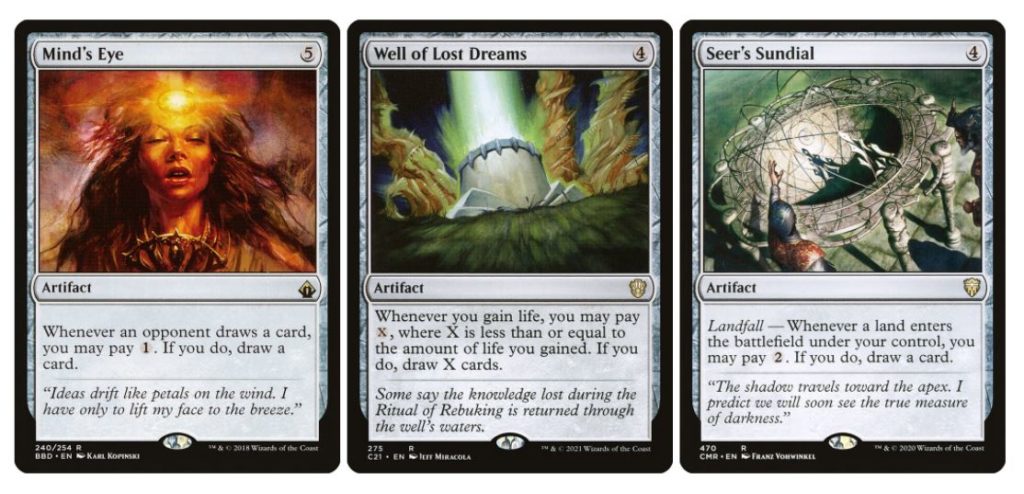
Mind’s Eye can help you keep up with the blue player at the table, or just draw an extra card per turn for a single mana. It’s expensive to cast, but you’ll get plenty of value from it if you have the mana to spend; at minimum, you’re guaranteed three extra cards per turn — one for each opponent’s draw step.
If you’re gaining life, you’ll probably want Well of Lost Dreams. Like Mind’s Eye, it’s a scalable effect where you can control the investment you put into it. White is the color that stands to benefit from this the most, considering its lifegain abilities and generally weaker options for card draw.
Seer’s Sundial is much more powerful than many players give it credit for. Much like Valakut Exploration, it rewards you for simply playing the game. It may cost two mana per use, but it’s well worth it.
I hope this has been helpful in identifying some of the more powerful card draw spells in Commander. Like I mentioned earlier, this is meant to be a basic guide; I strongly recommend doing your own searches for the right cards for your deck. The cards above may be generally good, but there’s always another card that’s just perfect for your specific deck!
What are your favorite card draw spells? Do you think there are other important ones to note? Let me know what you think over on Twitter. Happy brewing!

Scott is an Irish content creator and the Head of Budget Magic for the Izzet League. He focuses on affordable decks in Pioneer, Modern, and Pauper, particularly ones that stray from the mainstream. When he’s not writing about his favorite decks, he can be found talking incessantly about them on Twitter and on The Budget Magic Cast.

